Optimizing HVAC systems to decarbonize buildings
by arslan_ahmed | July 14, 2023 4:00 pm
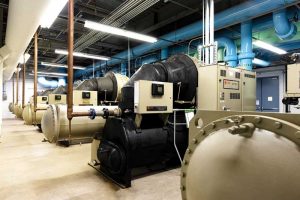 [1]
[1]By Michael Daly, PE
As the world continues to grapple with the effects of climate change, reducing greenhouse gas (GHG) emissions has become a top priority for governments, businesses, and individuals alike. One sector that has a significant impact on global emissions is commercial buildings. In fact, according to the International Energy Agency (IEA), commercial buildings are the fourth-largest emitters of CO2 globally.
Within commercial buildings, HVAC systems are responsible for 67 percent of the total emissions emitted. This presents a major challenge for facility managers, who balance the day-to-day operational demands of their buildings with the need to reduce carbon footprints and energy costs. With HVAC systems playing such a crucial role in occupant comfort and energy consumption, decarbonizing these systems is key to achieving facility sustainability goals.
Fortunately, new advanced technologies are being introduced to the industry that can help facility managers optimize their HVAC systems, save money, reduce emissions, and even extend equipment life. This article will explore one of the most common issues with commercial HVAC systems and how facility managers can not only remedy it, but also improve overall HVAC system performance which ultimately contributes to savings and less carbon emissions being emitted from the building.
The refrigerant-oil relationship
Before discussing a solution for improving the sustainability of HVAC systems, a clear understanding of the basic refrigerant-oil relationship is essential.
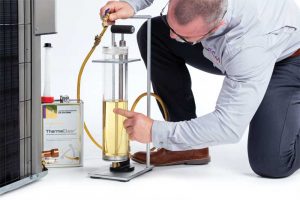 [2]
[2]Refrigerants and oil play a crucial role in the operation of almost every HVAC system, other than oilless magnetic bearing systems. Refrigerants are responsible for absorbing and releasing heat, while oil lubricates the system’s mechanical components to ensure smooth operation as well as dissipation of heat. Oil also works as a seal, minimizing compressed refrigerants from escaping from the compressor and ending up in the oil sump.
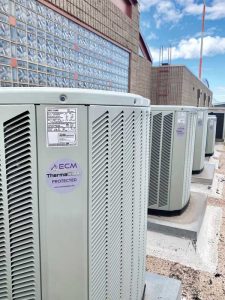 [3]
[3]The refrigerant-oil relationship is critical for maintaining system efficiency and preventing equipment breakdowns. Under normal circumstances, there will always be a small amount of oil that escapes a compressor’s crankcase and is circulated with the refrigerant throughout the system. For this reason, refrigerant oil and the refrigerant itself must be miscible.
The miscible mixture enables flowing refrigerant to continuously circulate oil through the system, returning most of the oil back to the compressor sump. However, over time, some of the oil begins to build up and form a thin film on the heat exchanger coils. This slow buildup of migrated oil is referred to as oil-fouling.
Oil-fouling is a common problem 99 percent of HVAC systems experience, resulting in significant reduction of efficiency. Over time, the accumulation of oil and other contaminants in the system’s heat exchanger can impede refrigerant flow, resulting in lower refrigerant velocity that compounds the problem of additional oil buildup. Inadequate refrigerant flow velocity enables oil to drop out of the flow, adhering to the heat exchanger coils. Additional oil buildup leads to poor heat transfer and decreased cooling capacity. This can result in equipment operating at 70 percent or less of its original capacity, leading to substantial energy loss and increased operating costs.
The buildup of oil and other contaminants within the heat exchanger coils means less oil in the compressor sump. This insufficient amount of oil can cause the mechanical moving parts of the compressor to suffer higher frictional loads, which in return could lead to system breakdowns and increased maintenance costs. As such, addressing oil-fouling is a critical step toward optimizing HVAC system performance and reducing energy consumption.
Reclaiming lost efficiency
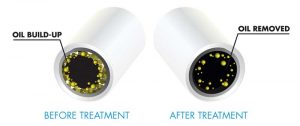 [4]
[4]To address the challenge posed by HVAC systems’ energy consumption and their contribution to carbon emissions, new advanced technologies are being introduced. Material science advances are yielding HVAC performance gains through wear-resistant additives to refrigerant oils, combined with refrigerant specific stabilizers, which are essential to maintaining material properties for the life of the equipment.
In addition to bolstering the refrigerant-specific oil properties, tailored additives that release oil from the heat exchanger surface also enable improved refrigerant velocities and strengthen heat transfer properties. These validated chemical cocktails offer facility managers an innovative way to restore lost efficiency and reduce carbon emissions.
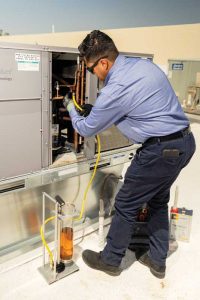 [5]
[5]Specific performance tested additives can reclaim 10 to 20 percent HVAC energy efficiency gains, and when coupled with extended equipment life, reduced maintenance, and deferred capital expenditures, operational savings can exceed 20 percent. Facilities personnel can achieve their goals of energy savings, operational cost savings, and extended equipment life that benefit capital budget plans as well.
The market perception of refrigerant and refrigerant oils
In the first few decades since the development of efficiency-improving formulations for refrigerants and refrigerant oils, the market has had mixed experiences with relatively poor adoption rates. Early attempts using solvents that degraded oil or formulations and included solids that negatively impacted expansion valves led to a persistent perception of “snake oil.” However, today, given advances in material science, the market is more receptive to newer technologies, moving away from the unproven formulations of the past. Trust is now earned by companies that offer professionally validated products with warranties.
Selecting the best materials
When looking to adapt new technology for an HVAC refrigerant system to reduce energy consumption and contribute to decarbonization, it is crucial to conduct proper due diligence and demand validated efficiency improvements. It is important to ensure the formulation of the technology is compatible with the specific equipment, refrigerant, and refrigerant oil. Despite that, many sales agents may not disclose or have knowledge of their respective chemistry, and most HVAC equipment managers are not chemists themselves, making assessments even more challenging. Therefore, it is advisable to seek credentialed validations and testing. Look for products that have been evaluated against American National Standards Institute (ANSI) standard compatibility tests and performance validated to ASHRAE or other accepted industry standards. By taking these steps, industry professionals can make informed decisions and select the most suitable technology for an HVAC system.
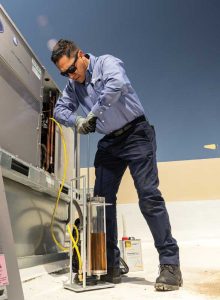 Conclusion
Conclusion
As the push for decarbonization continues to gain momentum, it is essential that facility managers take a closer look at the role HVAC systems play in emissions and energy consumption. By leveraging new technologies, they can improve the efficiency and sustainability of their buildings while also saving money in the process.
 Author
Author
- [Image]: https://www.constructionspecifier.com/wp-content/uploads/2023/07/Photo-Credit_ECM-Technologies.jpg
- [Image]: https://www.constructionspecifier.com/wp-content/uploads/2023/07/Image-1.jpg
- [Image]: https://www.constructionspecifier.com/wp-content/uploads/2023/07/Image-2.jpg
- [Image]: https://www.constructionspecifier.com/wp-content/uploads/2023/07/Image-3.jpg
- [Image]: https://www.constructionspecifier.com/wp-content/uploads/2023/07/Image-5.jpg
Source URL: https://www.constructionspecifier.com/optimizing-hvac-systems-to-decarbonize-buildings/